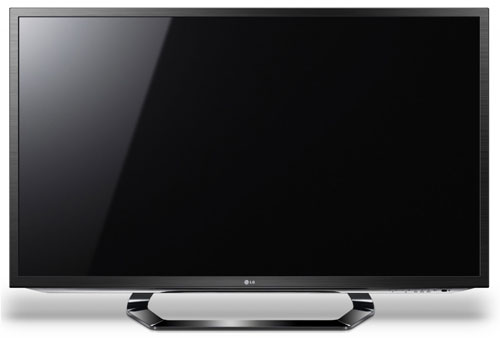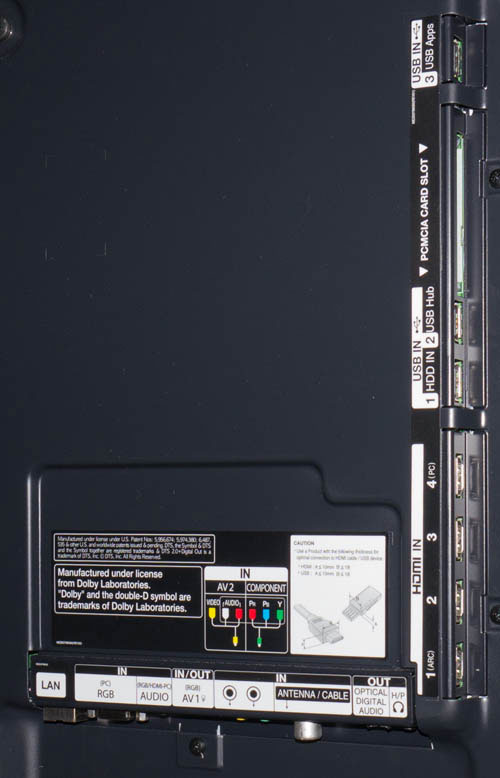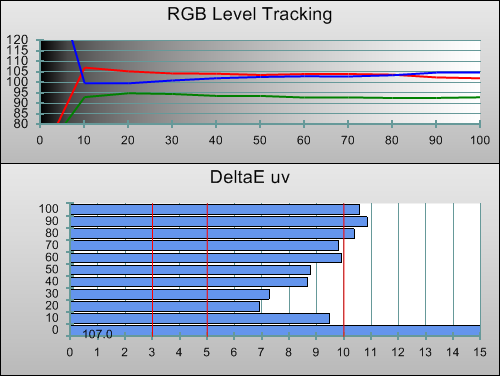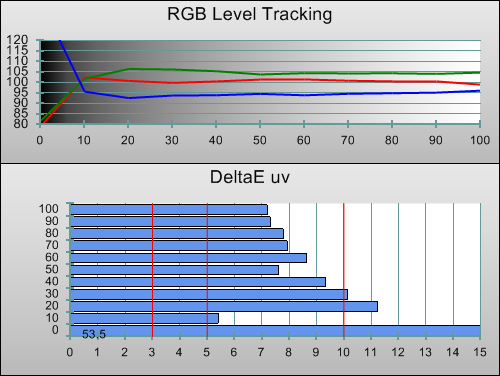LG Electronics isn’t a brand we see too much of here at HDTVTest, so we’re always happy to see their HDTVs come through for review. Today’s test subject is the LG 42LM620T, which boasts a 1920×1080 full HD panel (doesn’t every TV these days?), 4 HDMI inputs, a DVB-T2 (Freeview HD) tuner, and 3D support via the company’s passive technology (which its marketing people have cleverly called “Cinema 3D”). Like Panasonic’s LCDs, LG’s LCD televisions feature IPS panels, a type of LCD panel that typically does well with motion clarity and off-axis viewing quality (relative to other LCD types, that is), but doesn’t produce the deepest blacks on the market. These traits mean that IPS LCDs are a good choice for installation in very bright environments, where the latter weakness won’t be much of an issue.
The Korean manufacturer has a truly gigantic range of LED LCD TVs available, with the 42LM620T sitting somewhere in the middle of the lineup. Truth be told, the spec sheets alone reveal more similarities than anything else, with the differences appearing to be with styling, the number of 3D glasses included in the box, whether or not the LG “Magic Remote” is included, and the motion clarity rating. The LM620T doesn’t feature the Wii-like “Magic remote”, but comes with 4 pairs of passive 3D glasses (not that big a plus, given that compatible passive glasses can be bought at most cinemas for around £1). As an LG display, it also features ISFccc certification, and full 20-point Greyscale calibration controls, as well as a three-axis colour management system. Those don’t guarantee great picture quality, but it’s very reassuring to have this level of adjustability on an HDTV. Let’s find out if it can all come together to please the eyes and the wallet.
Note: While we did not review the larger, 47-inch LG 47LM620T, there shouldn’t be any significant difference in picture performance given similar specifications within the LM620T series.
Design
The LG 42LM620T is beautifully styled with a matte (yes – matte!) bezel surrounding the screen. It’s been styled with a “brushed steel” look, although it’s of course made of plastic. It reflects just enough light to look a little shiny, but nowhere near as much as the distracting “piano black” finishes on some flat-screen TVs. We’re very happy to see a television dispense with glossy styling, which is often highly reflective, as well as easily scratched.

The 42LM620 sits on top of a gloss black stand, though, which is a cheaper version of the silver chrome one that we’ve seen on a high-end LG LCD TV. Additionally, the LCD panel itself has been given a very slight gloss finish.
Connections
- 4 HDMI inputs
- 1 Component input
- 1 SCART input
- 1 Composite input
- 1 PC “VGA” input
- Aerial input (DVB-T2 / “Freeview HD”)
- 3 USB inputs
- Ethernet port
- Optical audio output
 |
| Rear connections on LG 42LM620T |
Operation
LG’s on-screen menus manage to be both clean and comprehensive. The top-level adjustment is the [Picture Mode], and we’re delighted to see two “Expert” modes, which have the Imaging Science Foundation Certified Calibration Configuration (ISFccc) logo beside them. These two modes unlock the full range of image calibration controls and can be configured to act as Day and Night viewing modes.
As well as basic picture setup controls, LG provides not a 20-point (yes, 20 point) Greyscale calibration screen, and a three-axis colour management system (CMS). There’s also a basic [Gamma] selection option.
![[Picture] menu](/news/wp-content/uploads/2018/04/hdtv_LG-42LM620T_picturemenu.jpg) |
|
| [Picture] menus | |
2D Calibration
Note: Our LG 42LM620T review sample was calibrated using Calman Professional, the industry-leading video calibration software.
We selected the “ISF Expert1” mode as a starting point for calibration. This mode, by default, has most of the picture-abstracting controls shut off, although [Edge Enhancer] came set to “High”, which we made sure to shut off. Also, [TruMotion] is set to “Smooth” by default. This will perform frame-interpolated motion smoothing on the image, giving films the “soap opera effect”. We’re not interested in watching films with motion errors and video-like movement, so we shut this off, too.
Then, we ran some Greyscale tracking measurements to see how well the 42LM620 was reproducing the colour of grey.
Greyscale
 |
| Pre-calibration RGB tracking and delta errors (dEs) |
Pre-calibrated images from the 42LM620T were predominately red-tinted compared to an ideal display. Unlike some other LED LCD TVs we’ve reviewed, the error is largely consistent (linear), and darker shades didn’t appear purple-tinged. This is good performance for a preset mode; the best accuracy requires each TV to be individually calibrated.
![Post-calibration RGB Tracking in [ISF Expert1] mode](/news/wp-content/uploads/2018/04/hdtv_LG-42LM620T_post-rgb.png) |
| Post-calibration RGB tracking and dEs in [ISF Expert1] mode |
The LG LM620T features 20-point calibration controls, which allow the colour of grey to be adjusted at 20 different points from black to white. While many HDTVs feature a 10-point control (allowing 10%, 20%, 30% stimulus, and so on, to be adjusted), the Korean brand offers double this precision. Ironically, the company is using IPS panels, which we often find to feature very linear Greyscale tracking anyway. In fact, we barely had to use the 20-point controls on our 42LM620T review sample: using the basic 2-point mode resulted in near perfect Greyscale tracking, and we only used the additional precision to correct a red tint in the shadows (at 5% and 10% stimulus).
Once we were done with this, Greyscale tracking on the television was visibly perfect. Calibrated Greyscale did still leave us with a very slight excess of blue at 90 and 100% stimulus. Normally we attribute this to digital clipping, which results from having the white level (“Contrast”) control set too high. To remove this invisible error, we’d have to reduce [Contrast] significantly. Because IPS LCD doesn’t do a great job in this area, we left this as it was.
One last note: the 42LM620T features the same behaviour as the high-end LG LED TV we recently reviewed, where bringing up the Greyscale calibration menu changes the backlight brightness. Therefore, you need to make an adjustment, then clear the menu from the screen to verify what you just did, because measuring with the raised backlight level will result in inaccurate readings.
Gamma
![Gamma curve in [ISF Expert1] mode](/news/wp-content/uploads/2018/04/hdtv_LG-42LM620T_post-gamma.png) |
|
| Gamma curve in [ISF Expert1] mode | Corresponding gamma tracking |
Of course, there’d have to be a fly in the ointment. Even before we touched the 20-point gamma controls (which can sometimes make a mess of gamma tracking if they’re not implemented well), we noticed that the LG 42LM620T was performing dynamic backlight adjustments during the measurement of dark shades. If we threw up a 100% stimulus (full brightness) test pattern and then jumped back to, say, 20% stimulus (dark grey), we could see the television slowly bring down the lighting.
Taking this dynamic behaviour into account, we remeasured using the APL patterns from the AVSHD test disc (the charts above are derived from those measurements). The dip upwards in the gamma tracking chart (above right) indicates that this behaviour stops at around 30% stimulus. It’s obvious why LG would program the TV to do this: it’s an attempt to conceal the mediocre black-level performance of the IPS panel. The real-world ramifications of this are that during dark scenes, the LM620 will dim the LED lighting to produce better black levels. That’s good, but the trade-offs are that the entire picture will be unusually dim during these scenes, with hard-to-see shadow details and slightly lessened colour saturation. This is even with the [Dynamic Contrast] control shut off. Although we didn’t think this ruined the experience, we’d appreciate being able to turn it off.
Colour
After Greyscale calibration, the previously off-hue secondary colours came in to an excellent level of accuracy. Like many LED LCD televisions we see, the 42LM620 couldn’t fully saturate the outer points of the gamut, meaning that it can’t meet the HDTV Rec.709 colour specification: red, green and blue are all slightly undersaturated on this display.
![Post-calibration CIE chart in [ISF Expert1] mode](/news/wp-content/uploads/2018/04/hdtv_LG-42LM620T_post-cie.jpg) |
| Post-calibration CIE chart with reference to HD Rec.709 |
Fortunately, the damage to the picture is minimal thanks to the fact that the colours are at least largely on-hue. Better yet, it was possible to correct the luminance levels of all colours to an essentially perfect standard using the [Colour Management] menu:
![Post-calibration Luminance levels in [ISF Expert1] mode](/news/wp-content/uploads/2018/04/hdtv_LG-42LM620T_post-colour-lum.png) |
| Post-calibration colour luminance (coloured bars = targets; black bars = measured values) |
| Post-calibration colour saturation tracking |
Saturation tracking measurements revealed good performance from the LG 42LM620T, keeping in mind what we already knew about the outer edges of the gamut triangle (the red, green and blue colours) being slightly off target.
3D Calibration
3D Mode Greyscale
 |
| 3D Pre-calibration RGB tracking and delta errors (dEs) |
LCD 3DTVs seem to have an easy time when it comes to Greyscale tracking in 3D mode. Granted, the tint of the polarized glasses themselves throws things off track, with the 42LM620T having a small but completely tolerable green tint before calibration. As usual for this display, the tint was basically linear from the darkest to the brightest grey shades.
![3D Post-calibration RGB Tracking in [ISF Expert1] mode](/news/wp-content/uploads/2018/04/hdtv_LG-42LM620T_3d-post-rgb.png) |
| 3D Post-calibration RGB tracking and dEs in [ISF Expert1] mode |
Thanks to the linear nature of the tint, greyscale calibration only took a few minutes (no exaggeration). We only had to adjust the 20-point controls at 5% and 10% stimulus – the errors elsewhere were at an insignificant level. We were left with perfect greyscale tracking in the third dimension.
3D Mode Colour
Colour in 3D was much the same as in 2D. We’ve often found that 3DTV sets which manage perfect Rec.709 gamut coverage in 2D don’t achieve the same in 3D, with the glasses limiting the colour gamut. That’s not an issue here, because the LG LM620T can’t achieve full saturation in 2D. In other words, there’s nothing else to lose, so the result here is basically the same.
![3D Post-calibration CIE chart in [ISF Expert1] mode](/news/wp-content/uploads/2018/04/hdtv_LG-42LM620T_3d-post-cie.jpg) |
| 3D Post-calibration CIE chart with reference to HD Rec.709 |
![3D Post-calibration Luminance levels in [ISF Expert1] mode](/news/wp-content/uploads/2018/04/hdtv_LG-42LM620T_3d-post-colour-lum.png) |
| 3D Post-calibration colour luminance (coloured bars = targets; black bars = measured values) |


My comment has nothing to do with this tv, for that i’m sorry.
When are you going to review an philips LCD tv like the 8007?
Regards
David – Another good one, I won’t buy a tv unless you’ve seen it first! To your knowledge is there a 37-42″ (limited viewing distance) tv that is NOT black (wont go with the decor) that does not have clouding/ light leaking issues and decent black level. Or shall I continue to wait? Still working with my Sony Trinitron which has zero issues picture wise apart from screen glare but I really want a bigger screen now :o| I too would be interested in a Philips review, the 7007 looks like its got a Samsung panel so blacks should be decent for a start!
@Chris: we haven’t had a Philips review sample submitted in years. We could ask them for some though? I’ll pass the message along!
@Jonathan: a TV that isn’t black? Very tough to find in higher than small sizes. And that doesn’t have uniformity issues? That’s a nearly impossible combination I’m afraid. Plasma displays have much better uniformity but start at 40″ or so in size.
We’ll try to get some Philips displays. I’d love to see how they’re doing these days.
Hi David. Great reviews. I’d like to see some philips review too if possible,especialy for mid-range tvs like the new PFL4007 or PFL4307 (3D passive).I’m looking to exchange my old LCD Samsung 32A656(that i use as PC monitor) with 40(42) incher LED wich also does good as a PC monitor (low input lag , 4:4:4 chroma )
Hi David,
Great review as always. It would be great if you did a review on a Philips LED-LCD TV, for example the mid-range 6007. I just bought and I am happy with it, but it would be great to see how what you think, and what settings you would use.
Thanks,
BB
Hi David,
An interesting review, especially the part on the SD processing of this Tv. I own an LG tv currently and although lower end LK430 have been impressed by the Sd performance (even in PAL transmissions). Do you think that with this LG Tv s currently superior in this aspect compared to Samsung and Toshiba mid range models ?
Are you talking about analogue/composite PAL? That’s not something I tested (since the transmissions no longer take place in the UK).
Having looked at some mid range Samsung LCDs, I’d say LG’s video processing for SD is slightly better than some of the stuff they deploy (the MStar chips), but not by far.
Hi david
The undefeatable backlight dimming is sure even if the energy saving is disabled?
Does anyone know if a newer firmware fix it and if exist on lower model LM611?
Thanks
Hi David
Could you please post the calibration settings of this TV?
Best regard,
Kjetil
Thanks for the review mate. And keep up the good work!.
I have been looking for the cheap 55″, low input lag LED TV forever and eventually you’ll review one for sure.
The review is for the 42″ version of the series.. Do these numbers carry on to higher dimensions too? like the 47LM620 or 55LM620..
I suspect it should but, I really rather not figure out the wrong way that it does not.
Could you post the calibration settings, please. I could try to use them with my 55″ version.
Awesome review.
I have been stuck between 2 tv’s…. this one the Panasonic TX-L42E5B.
Panasonic has better picture. Once the LG is calibrated how does it compare?
Can you please send me the calibration settings for this set.
Thanks
Please mail me the settings PLEASE
me too (calibration settings)
Would be very gratefull if you could send me the calibration settings for the LG LM620T by email
Thanks in advance!
I’m interested in how they can get to the calibration settings for LG42LM620/640?
considering picking one of these up soonish as my G30 is showing signs of screen burn due to heavy PS3 use.
Couple of questions..
is the 31ms input lag using game mode, or renaming input to PC, or is it a combination on both. I know from my old Samsung 656 this trick works on the 360 but not the PS3.
When you reviewed the set did you notice much backlight bleed, clouding?
oh forgot to ask.
When using game mode, does the LG still allow the user to adjust basic settings eg sharpness, colour ect. I remember my Samsung 656 had a game mode but was useless as all the user settings were locked out and the image was horribly sharp.
Great review, just bought my 37LM620s and i noticed some issues with the motion clarity in the news flashes bands in news channels like CNN etc. The writing is very very blurry. Anyone has ideas how to remedy?
Also, please send me the calibrations settings. Cheers!
Thanks for another very thorough review. Although I know that individual panels vary in performance, I would appreciate if you could email me your test settings as a good starting point for my own setup.
Thanks again.
me too (calibration settingsLG LM620) please
Would love to be able to get/see the best calibration settings for this tv -LG 42LM620T.
Did anyone in the forum get them?
Thank you in advance hopefully?
Hi,
Like many others you could post or e-mail the calbration settings if not anyone who has them could you post them?
Cheers
Please mail me the settings PLEASE
Hi i have LG LM620T,would someone plese send me calibration settings please
Just bought this TV, 47LM620T and watched Finding Nemo 3d yesterday and it blew my away
Would be super happy if you or someone else in here could email me the calibrated [ISF Expert1] mode settings used in the Review.
Cheers
Recently purchased this TV due to my budget and this review.
I am really happy with my purchase.
Like the other posters before me I would also like access to the calibrated settings that were used for this review.
Thanks
Did anyone get the calibrated settings if so could you forward them to mhanda@gmail.com
Thanks,
Marcus
Hello, I’d like to know if the 31ms input lag is only when the tv is under game mode?
Hi David.
Very heplful review.Im really consider to buy this tv but i have a question about motion rate.You said”The LG LM620T doesn’t feature a 100hz or 200hz-capable LCD panel” but on currys website it said its 100hz(here’s the link http://www.currys.co.uk/gbuk/lg-42lm620t-full-hd-42-led-3d-tv-12424957-pdt.html?srcid=3&cmpid=comp~Pricerunner~TV%2c+DVD+%26+Blu-ray~12424957 )and on amazon uk its even state that MCI on LG LM620T is 400hz (here’s the link http://www.amazon.co.uk/LG-42LM620T-42-inch-Widescreen-Freeview/dp/B007IYW3HO/ref=sr_1_2?s=electronics&ie=UTF8&qid=1358170046&sr=1-2 ) Amazon said their model is new for2012.If you be so kind could you clarify this issue because im confused about those different ratings.Thanks for help.
Best regards
Hi! Can u send me setups for me email? Thanks a lot allready :)
Dear David,
Excelente review. Congratulations. I just acquired a 65lm6200.
Could You please send the calibration settings ?
Thanks
Doesn’t feature 100hz panel?
Are you sure?
HI! Could you send me calibration settings? Thank you!
Hi, great review,
Could you post and/or send me the calibration settings via mail.
Pleaaaase?
Pretty, pretty please :-)
Nice review. Would be nice to publish the calibration settings aswell (if not possible, i would love to receive an email with your settings).
nice work!
i’m also interested in the calibration settings – can someone please send it via mail?
hi could you email me the calibration settings please many thanks
could you please email me your settings please , i would appreciate it
many thanks
mike
I recently bought the new 2103 LG 3D Smart Tv and have been experiencing some interesting/nauseating effects. I am curious if you or anyone else have felt a kind of motion sickness after watching from this tv? After just a few minutes of watching regular tv i begin to experience an intense headache and eyestrain followed by nausea. I just calibrated it to some of your settings to see if it will make any difference. If not I am afraid I may have to return it.
Could it be that the LED is affecting me and that a Plasma may be a better choice?
Any advise would be greatly appreciated.
Thank you kindly,
Shannon
I would also very much appreciate the calibration settings mailed :)
Thanks for your review!. I am very curious in your used settings for both 2d and 3D. Can you email them to me?
Thanks in avance.
Remco
Hi, is it possible to get your calibration settings on mail, i would really appreciate it
thanks in advance,
Marko
I am torn between purchasing the LG 47LM6200 and the Samsung 46ES6200 can you please advise me which one to go for. What I want is an HD,3D Smart LED TV in this size range that is durable and will last. Also the price different isn’t much hence my inability to decide.
Thanks in advance